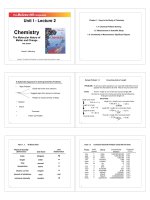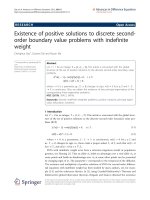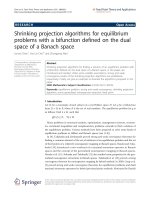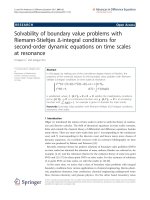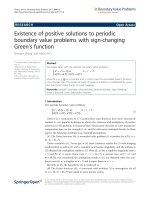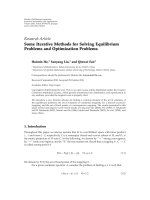Solving Contact Problems with Abaqus
Bạn đang xem bản rút gọn của tài liệu. Xem và tải ngay bản đầy đủ của tài liệu tại đây (9.37 MB, 325 trang )
Ι www.3ds.com Ι © Dassault Systèmes Ι Confidential Information Ι 18/03/2013 ref.: 20100928MKT038 Ι
Solving Contact Problems with Abaqus
DS UK Ltd, Coventry - March 2013
Stephen King
Tony Richards
Ι www.3ds.com Ι © Dassault Systèmes Ι Confidential Information Ι 18/03/2013 ref.: 20100928MKT038 Ι
Seminar Abstract
Contact interactions between different parts play a key role when simulating
bolted assemblies, manufacturing processes, dynamic impact events, and
various other systems. Accurately capturing these interactions is essential for
solving many engineering problems. SIMULIA has developed state-of-the-art
contact modeling capabilities in Abaqus.
Attend this seminar to learn the latest techniques and strategies for solving
difficult contact problems with Abaqus. This seminar primarily focuses on
Abaqus/Standard, with additional discussion of Abaqus/Explicit.
Topics include advantages of the general contact capability, accurate contact
pressures, insight on numerical methods, tips for improving convergence,
recent enhancements to the implicit dynamics procedure for contact models,
and proper representation of physical details associated with contact.
Ι www.3ds.com Ι © Dassault Systèmes Ι Confidential Information Ι 18/03/2013 ref.: 20100928MKT038 Ι
Lectures
• Lecture 1:
Introduction
• Lecture 2:
Defining Contact in an Analysis
• Lecture 3:
Numerical Methods for Contact
• Lecture 4:
Contact Output and Diagnostics Tools (start)
(Lunch) 12:30pm – 1.30pm
• Lecture 4 (cont.): Contact Output and Diagnostics Tools (finish)
• Lecture 5:
Convergence Topics
• Lecture 6:
Contact in Abaqus/Explicit
• Lecture 7:
More Features
Ι www.3ds.com Ι © Dassault Systèmes Ι Confidential Information Ι 18/03/2013 ref.: 20100928MKT038 Ι
Legal Notices
All Dassault Systèmes Software products described in this documentation are available only
under license from Dassault Systèmes or its subsidiary/subsidiaries and may be used or
reproduced only in accordance with the terms of such license.
The information in this document is subject to change without prior notice. Dassault Systèmes
and its subsidiaries shall not be responsible for the consequences of any errors or omissions
that may appear in this documentation.
No part of this documentation may be reproduced or distributed in any form without prior
written permission of Dassault Systèmes or its subsidiary/subsidiaries.
© Dassault Systèmes, 2013.
Printed in the U. S. A.
The 3DS logo, SIMULIA, CATIA, 3DVIA, DELMIA, ENOVIA, SolidWorks, Abaqus, Isight, and
Unified FEA are trademarks or registered trademarks of Dassault Systèmes or its subsidiaries
in the US and/or other countries. Other company, product, and service names may be
trademarks or service marks of their respective owners.
Ι www.3ds.com Ι © Dassault Systèmes Ι Confidential Information Ι 18/03/2013 ref.: 20100928MKT038 Ι
Introduction
Lecture 1
Ι www.3ds.com Ι © Dassault Systèmes Ι Confidential Information Ι 18/03/2013 ref.: 20100928MKT038 Ι
Overview
• General Considerations
• Evolution of Contact in Abaqus
• Contact Examples
Ι www.3ds.com Ι © Dassault Systèmes Ι Confidential Information Ι 18/03/2013 ref.: 20100928MKT038 Ι
General Considerations
• What is contact?
• Physically, contact involves interactions between bodies
• Contact pressure resists penetration
Fairly
intuitive
• Frictional stress resists sliding
• Electrical, thermal interactions
• Numerically, contact includes severe nonlinearities
Numerically
challenging
• Inequality conditions result in discontinuous
―stiffness‖
• Gap distance: dgap ≥ 0
• Frictional stress: t ≤ mp
• Conductance properties suddenly change
when contact is established
Ι www.3ds.com Ι © Dassault Systèmes Ι Confidential Information Ι 18/03/2013 ref.: 20100928MKT038 Ι
General Considerations
• Various classifications of contact interactions can be considered
• Example: slender or bulky components
• Bulky components:
• Typically many nodes in contact
at one time
• Contact causes local deformation
and shear, but it causes little bending
• Slender components
• Often relatively few nodes in contact at
one time
• Contact causes bending
• Often more challenging
Ι www.3ds.com Ι © Dassault Systèmes Ι Confidential Information Ι 18/03/2013 ref.: 20100928MKT038 Ι
General Considerations
• Classifications of contact
interactions:
• Slender or bulky components
• Deformable or rigid surfaces
• Degree of confinement and
compressibility of components
• Two-body contact or selfcontact
• Amount of relative motion
(small or finite sliding)
• Amount of deformation
• Underlying element type (1st or
2nd order)
• Interaction properties (friction,
thermal, etc.)
• Which results are of interest
and importance (e.g. contact
stresses)
Ι www.3ds.com Ι © Dassault Systèmes Ι Confidential Information Ι 18/03/2013 ref.: 20100928MKT038 Ι
„Ingredients‟ of a Contact Model
• Contact surfaces
• Surfaces over bodies that may experience contact
• Contact interactions
• Which surfaces interact with one another?
• Surface property assignments
• For example, contact thickness of a shell
• Contact property models
• Examples: pressure vs. overclosure relationship, friction coefficient, conduction
coefficients, etc.
• Contact formulation aspects
• For example, can a small-sliding formulation be used?
• Algorithmic contact controls
• Such as contact stabilization settings
Many of these aspect need not be
explicitly specified
Ι www.3ds.com Ι © Dassault Systèmes Ι Confidential Information Ι 18/03/2013 ref.: 20100928MKT038 Ι
General Considerations
• Physical and numerical aspects of contact modeling:
• User responsible for defining physical aspects of model
• User and Abaqus control various numerical aspects
• Many details (e.g., slender or bulky classification) need not be
explicitly specified
• Trend toward greater automation
Ι www.3ds.com Ι © Dassault Systèmes Ι Confidential Information Ι 18/03/2013 ref.: 20100928MKT038 Ι
Evolution of Contact Modeling in
Abaqus
Ι www.3ds.com Ι © Dassault Systèmes Ι Confidential Information Ι 18/03/2013 ref.: 20100928MKT038 Ι
Evolution of Contact Modeling
Contact elements
(e.g., GAPUNI):
Contact pairs:
General contact:
2
n
v
h
1
h d n u2 u1 0
User-defined element for
each contact constraint
Many pairings
for assemblies
Trends over time
Model all interactions
between free surfaces
Ι www.3ds.com Ι © Dassault Systèmes Ι Confidential Information Ι 18/03/2013 ref.: 20100928MKT038 Ι
Evolution of Contact Modeling
Flat approximation of master
surface per slave node:
Master surface
Realistic representation of
master surface:
Master surface
Trends over time
Ι www.3ds.com Ι © Dassault Systèmes Ι Confidential Information Ι 18/03/2013 ref.: 20100928MKT038 Ι
Evolution of Contact Modeling
Slave surface treated as
collection of discrete points:
Constraints based on
integrals over slave surface:
Does not resist
penetration at
master nodes
Resists penetration
at slave nodes
Good resolution of
contact over the
entire interface
Trends over time
Ι www.3ds.com Ι © Dassault Systèmes Ι Confidential Information Ι 18/03/2013 ref.: 20100928MKT038 Ι
Evolution of Contact Modeling
• Goals: improve usability, accuracy, and performance
• More focus by user on physical aspects
• Less on idiosyncrasies of numerical algorithms
• Broad applicability
• Large models (assemblies)
General contact:
Constraints based on
integrals over slave
surface:
Realistic representation of
master surface:
Master surface
Good resolution of
contact over the
entire interface
Model all interactions
between free surfaces
Ι www.3ds.com Ι © Dassault Systèmes Ι Confidential Information Ι 18/03/2013 ref.: 20100928MKT038 Ι
Evolution of Contact Modeling
• General contact algorithm
• Contact domain spans multiple bodies
(both rigid and deformable)
• Default domain defined automatically
via all-inclusive, element-based surface
• Method geared toward models with multiple
components and complex topology
• Greater ease in defining contact model
• Available in Abaqus/Explicit since 6.3
• Available in Abaqus/Standard since 6.8-EF
Ι www.3ds.com Ι © Dassault Systèmes Ι Confidential Information Ι 18/03/2013 ref.: 20100928MKT038 Ι
Evolution of Contact Modeling
• Transition to general contact nearly complete for Abaqus/Explicit
• Most Abaqus/Explicit analyses use general contact
• Easy to use and robust
• Accuracy, performance, and scalability as good or better than contact pairs
• Some features available only in general contact
• A few features available only with contact pairs
Ι www.3ds.com Ι © Dassault Systèmes Ι Confidential Information Ι 18/03/2013 ref.: 20100928MKT038 Ι
Evolution of Contact Modeling
• Transitioning to general contact in Abaqus/Standard
• Good feedback
• Easier to create model than contact pairs
• Similar robustness and accuracy as contact pairs
• Some extra contact tracking time, etc.
• Contact pairs are required to access specific features not yet available
with general contact
• Analytical rigid surfaces
• Node-based surfaces or surfaces on 3-D beams
• Small-sliding formulation
• See the Abaqus Analysis User’s Manual
• General contact and contact pairs can be used together
• General contact algorithm automatically avoids processing interactions
treated with contact pairs
Ι www.3ds.com Ι © Dassault Systèmes Ι Confidential Information Ι 18/03/2013 ref.: 20100928MKT038 Ι
Contact Examples
Ι www.3ds.com Ι © Dassault Systèmes Ι Confidential Information Ι 18/03/2013 ref.: 20100928MKT038 Ι
Contact Examples
• Contact between linear elastic bodies with small relative motion
• Common design problems involving:
• Small relative motion
• Significant contact area
• Typical examples:
• Bearing design
• Hard gaskets
• Interference fits
• Fretting (surface wear) is
often a concern, requiring
accurate resolution of contact
stresses and stick/slip zones
Ι www.3ds.com Ι © Dassault Systèmes Ι Confidential Information Ι 18/03/2013 ref.: 20100928MKT038 Ι
Contact Examples
• Deformable-to-rigid contact
• Finite sliding between
surfaces (large
displacements)
• Finite strain of deforming
components
• Typical examples:
• Rubber seals
• Tire on road
• Pipeline on seabed
• Forming simulations
(rigid die/mold,
deformable
component)
Example: metal forming simulation
Example taken from ―Superplastic forming of
a rectangular box,‖ Section 1.3.2 in the
Abaqus Example Problems Manual
Ι www.3ds.com Ι © Dassault Systèmes Ι Confidential Information Ι 18/03/2013 ref.: 20100928MKT038 Ι
Contact Examples
• Finite-sliding contact between
deformable bodies
• Most general category of
contact
• Example: twisting blocks
• Press together and
relative rotation of 90°
Ι www.3ds.com Ι © Dassault Systèmes Ι Confidential Information Ι 18/03/2013 ref.: 20100928MKT038 Ι
Contact Examples
• Self-contact
• Type of finite-sliding,
deformable-to-deformable
contact
SURF1
(rigid)
SURF2
• Contact of a single body with
itself—often involves severe
deformation
• Sometimes adds CPU
expense and numerical difficulty
• General contact implementation
somewhat like self-contact of
surface spanning multiple
bodies
Contour of minimum principal stress
Example: compression of a rubber gasket
Example taken from ―Self-contact in
rubber/foam components: rubber gasket,‖
Example Problem 1.1.18 in the Abaqus
Example Problems Manual
Ι www.3ds.com Ι © Dassault Systèmes Ι Confidential Information Ι 18/03/2013 ref.: 20100928MKT038 Ι
Lecture 1 Summary

